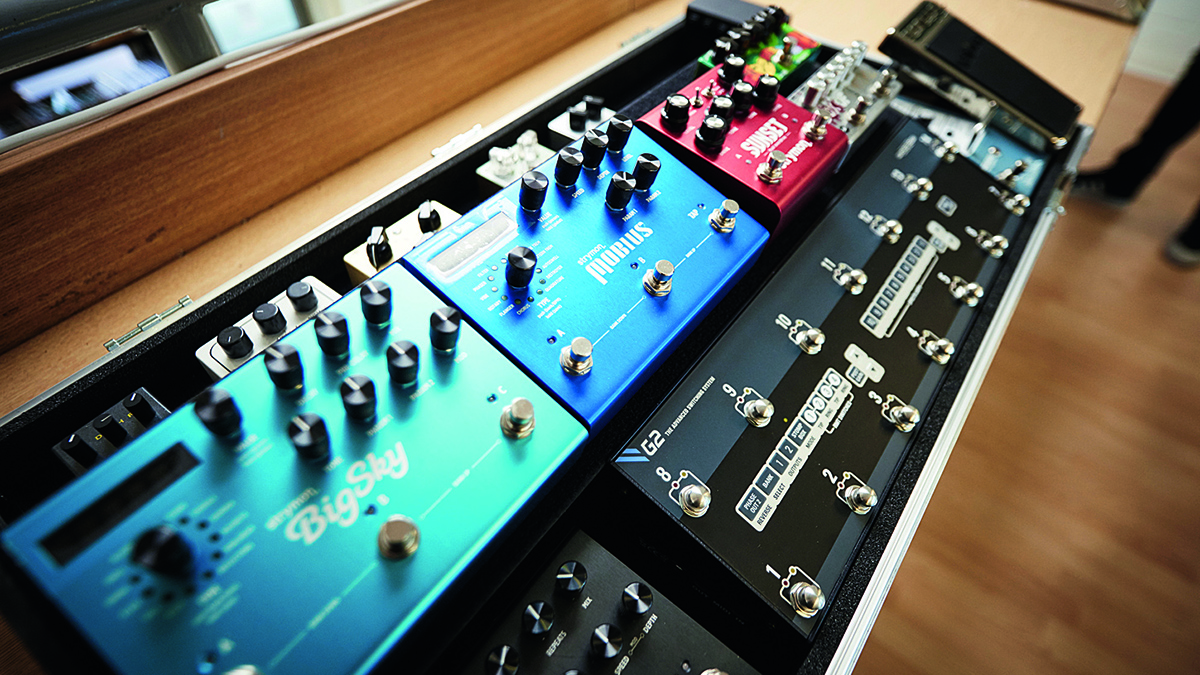11 ways to get more from your delay and reverb pedals
Reverb and delay add space and ambience but they can do much more. Here we look at approaches for more extreme sounds – and some applications for better tone in a mix

So you've got a reverb pedal, you've got a day, you've got them on your pedalboard and they're doing just fine. But is there anything more you could be getting out of them?
Here we are going to look at 11 ways you can use your reverb and delay pedal for something different, perhaps a little studio polish with a reverse guitar effect, or something more dramatic for the post-rock crowd.
1. Single-shot studio reverse
To mimic the ’70s-style effect of reversing your guitar sound in the studio, you can use this trick. Set a delay to reverse mode, then turn feedback down to a single repeat and the level up to max (or unity with the dry signal). Live, the gap between playing and repeat shouldn’t be an issue.
When recording, simply play to a click with the monitoring off, then drag the waveform back to the start of the passage. If you played to the click, it should be in time, apart from the initial offset caused by the buffer size.
2. Verb into drive
There are few things as rock ’n’ roll as running a reverb into a drive, distortion or fuzz pedal. Conventional wisdom says to order these effects the other way around, but for runaway train washes of distorted reverb, this is far more attention-grabbing! For bonus points use a reverb that has an infinite or swell mode for pure noise bliss.
3. Parallel delays
Instead of using reverb, get more defined but disorientating ambience by running two mono channels of delay panned right and left. Set the times differently, and listen to the repeats as they converge and diverge in complex patterns. Some psychedelic and shoegaze guitarists used this trick for space cadet guitar sounds.
4. Lower the treble on tails and repeats
Reverb tails can quickly swamp your dry signal. Especially at longer decay or dwell settings, managing the tone of reverb tails is key. Beyond short slapback and room effects, as reverb time goes up, tails need to have their treble rolled off, similar to how high frequency content would be dampened in real spaces. This can also apply to delay tails, and it’s why BBD or analogue delays gel into a band mix so well.
Get The Pick Newsletter
All the latest guitar news, interviews, lessons, reviews, deals and more, direct to your inbox!
5. Max those controls!
There’s a lot of crossover between digital buffered time effects like delay, reverb, loopers and pitch shifters. Try maxing out the controls in odd combinations, to unlock oddities such as fake harmonisation, oscillation, machine-gun repeats, and more. Take the classic intro to Bloc Party’s debut album, Silent Alarm, for example. Its eerily drifting digital repeats are caused by dimed feedback and level controls.
6. Post-rock tremolo picking
Countless post-rock acts have used tremolo picking to create a wash of noise. Choose a delay and set it to a moderate length, with the effect level rolled back slightly, then tremolo pick to create a cascading shower of notes.
As you change frets, the repeats will blend single-note lines into a complex pad. Using a reverse delay will mean there’s a slight lag between dry and wet, ideal for phrases with faster note changes.
7. Experiment with auto‑oscillation
What happens when you turn delay feedback to max? Auto-oscillation, where the delays run away, increasing in pitch and creating a drone that can be tuned to a note. Think the end of Radiohead’s Karma Police (although that was a tape echo). This is mostly only available on analogue delays, but some digital delays will oscillate, or even do stranger things, like create glitchy loops.
8. Remember the different timbres of delay types
If you’re using a digital delay and the repeats are getting in the way of your playing, first reduce the effect level. If there’s still something a little off, reduce the treble if possible. If that still doesn’t do it, the clinical nature of a digital delay might not be for you. Switch to a darker analogue or tape mode if you’re using a multi-effect, or pick up a BBD-based delay.
9. The Drone Ranger
Reverbs and delays go excellently with tremolo-picking, so it should come as no surprise that they also sound ace with drones. The combination of say, E-Bow drone notes and longer time settings allows you to create synth-like pads. If you don’t have an E-Bow, then try volume swelling in a distorted guitar and capturing it with a looper in front of your time effects.
10. Machine gun repeats
Using a looper or delay with the time set to its quickest repeat, you can capture a tiny buffer of audio and have it immediately play back. This machine-gun, typewriter-like rattle of repeats is a staple of riff articulation in genres like math and post-rock, as well as modern tech metal.
11. Don’t use too high decay or feedback settings
Managing the dwell, decay or feedback control for reverb, and the feedback control for delay, is essential to sounding good. At home or playing solo, longer times sound amazing, giving you the feeling you’re playing in a concert hall.
In a band, live or recording mix however, longer times left unchecked can result in muddiness, phase issues, and a lack of clarity. When in doubt, pull the control back until you can barely tell the effect is on, then turn it up until it sounds most impactful.
Total Guitar is one of Europe's biggest guitar magazines. With lessons to suit players of all levels, TG's world-class tuition is friendly, accessible and jargon-free, whether you want to brush up on your technique or improve your music theory knowledge. We also talk to the biggest names in the world of guitar – from interviews with all-time greats like Brian May and Eddie Van Halen to our behind the scenes Rig Tour features, we get you up close with the guitarists that matter to you.
“Sonically excellent… we found that it could be a viable substitute for our vintage 1970s pedals”: Hamstead x That Pedal Show Redwing Analogue Stereo Modulator review
“The original Jordan Boss Tone was probably used by four out of five garage bands in the late ’60s”: Unpacking the gnarly magic of the Jordan Boss Tone – an actual guitar plug-in that delivers Dan Auerbach-approved fuzz


![John Mayer and Bob Weir [left] of Dead & Company photographed against a grey background. Mayer wears a blue overshirt and has his signature Silver Sky on his shoulder. Weir wears grey and a bolo tie.](https://cdn.mos.cms.futurecdn.net/C6niSAybzVCHoYcpJ8ZZgE.jpg)

![A black-and-white action shot of Sergeant Thunderhoof perform live: [from left] Mark Sayer, Dan Flitcroft, Jim Camp and Josh Gallop](https://cdn.mos.cms.futurecdn.net/am3UhJbsxAE239XRRZ8zC8.jpg)





